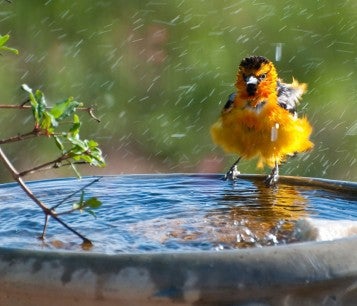Snakes instill a deep-rooted fear in many people that few other animals can match. Even other animals seem to put them in a special category; many wild animals recognize snakes as threatening, and some birds and monkeys even have special vocalizations for sounding an alarm when a snake is seen.
But there’s no justification for the persecution of these animals and the acts of violence often committed when even the most harmless of them is sighted. Snakes suffer greatly from changes in their habitat. Isolated when their natural land is broken up by development, they can’t easily move across the unfriendly terrain. Many species are either already gone or are rapidly disappearing from city and suburb, lowering the number of human-snake conflicts, but depriving those who delight in encountering them that pleasure.
Snakes cause few problems, and the few they do are relatively benign. Some of the larger species may cause problems around poultry houses, occasionally taking chicks or eggs, but—except for the venomous species—snakes are not a threat to humans or their pets. That does not convince people who have a deep-seated fear of these animals that they are harmless, and the fear some people have at even a glimpse of these reptiles contributes mightily to what are real conflicts between humans and snakes.
Contents
No matter how big or small your outdoor space, you can create a haven for local wildlife. By providing basic needs like water, food and shelter, you can make a difference in your own backyard.

What do I do if I encounter a snake?
Most encounters with snakes are passing, but when one does occur, be sure to:
- Leave the snake alone.
- Identify it by species.
- Continue to leave it alone so long as it is not venomous and not inside a house or building.
All outdoor (even in your yard) encounters with nonvenomous snakes should be resolved by letting the animal go its own way, most likely to never be seen again.
Venomous snakes are another matter. If you encounter a venomous snake in your yard, take it seriously. The snake should be removed to ensure that no one, including pets, gets hurt. Note: This does not mean the snake has to be killed. In many places, you can call animal-control or local police or fire departments to remove the snake. What happens after that may be problematic, since most poisonous snakes have well defined ranges in which resources, such as winter dens (hibernacula), are critical to their survival. Moving snakes into unfamiliar territory may compromise their chances to survive.
Your local animal control agency is the best place to start looking for someone knowledgeable about snakes who can give advice about the best course of action when a snake must be removed. Many states have herpetological associations and university extension specialists may be good sources of information or able to network with others who are.
Exclusion (preventing entry or re-entry)
Excluding snakes from buildings can be as difficult as excluding rodents, and keeping snakes out of yards or gardens may be completely impractical.
Snakes in houses may be there either accidentally (for instance, washed in by flood waters) or purposely to find prey or shelter. They can become trapped inside and may die from lack of food or moisture if not captured and removed.
Note: Some snakes may hibernate in cellars or crawl spaces of older houses. The presence of shed skin usually indicates that a snake has been living in the house for some time.
How do I remove a snake from my house?
If you discover a snake in your house, act as soon as possible, for both the snake’s and your peace of mind:
- Remain calm and avoid disturbing the snake or driving them into hiding.
- If possible, carefully open a nearby door and use a broom to gently herd the snake outside.
- If you can’t herd the snake—and it’s small or coiled, slowly place an empty pail or wastebasket over them, then put a weight on top to trap the snake until an experienced handler arrives.
- If getting the snake outside is impossible and the above is also, try to confining them to a room or corner them with barriers such as boards or boxes, so that they will be easy to capture when the expert arrives.
If you know there is a snake in your house, but you can’t find them, consider this: snakes like warmth and darkness, and a heating pad or even a pile of burlap or other material on the basement floor may attract the unwanted visitor, who can then be trapped and handled.
If you aren’t afraid of snakes and believe you can do so without harming either the snake or yourself—and you are certain it is not a venomous species—you can consider putting on gloves, gently picking up the snake and carefully relocating them outside.
How can I inspect and snake-proof my property?
If you’ve found a snake in your house—or if you want to avoid finding one, you can snake-proof your home. Snakes usually enter buildings at ground level, some fitting through tiny cracks or holes no more than one-eighth inch wide.
- Closely inspect the foundation for unsealed wire or pipe conduits or basement windows or doors that do not seal tightly and seal these openings immediately. (You can use the same methods you’d use to keep out rodents.) Look for openings at or near ground level (If you’ve already found a snake in your house, remember what size he was and look for openings large enough for the snake’s head to pass through.)
- Some snakes are also good climbers, and trees, shrubs, stone walls or chimneys may provide access to the roof. So be sure to check for openings around the eaves and roof. Inspect behind concrete porches, steps and where decks attach to the house.
- Once the entire exterior has been inspected and one or more openings have been discovered, decide which opening is likely to be the main snake entrance.
- Seal all the openings except the suspected main entrance. On that opening, install a one-way door for snakes.
One-way snake doors
You can make your own one-way door to help evict snakes from a building.
- Roll a piece of aluminum window screen into a 10 inch cylinder slightly larger in diameter that the entrance hole.
- Insert the roll into the snake entrance.
- Suspend the outlet end a few inches off the ground, so the snake can exit but not reenter.
- Leave it in place a month or longer—if you install it in the fall, leave it in place until late spring.
- Once the snake has left, remove tube and permanently seal the opening.
Habitat management
Reduce the chance of a snake moving in your yard by making it less attractive (to snakes, at least). Removing potential hiding places for both snakes and their prey including:
- Piles of rocks, wood, or other debris.
- Tall grass and undergrowth.
- Cracks around concrete porches and sidewalks.
- Storage sheds with space under the floor.
Note: Pet foods and household garbage left outside overnight attract rodents, which, in turn, may attract snakes.
Can I use repellents?
There are commercially marketed repellents for snakes, ranging from sisal rope to sulfur. However, we cannot confirm that any effective product exists to repel snakes humanely.
What if I get bitten by a snake?
Snakes are not known to transmit any disease to humans. When a non-poisonous bite breaks the skin:
- Treat the wound like any other puncture wound that can get infected.
- Immediately consult a physician.
If bitten by a poisonous snake:
- Call 911 or transport victim to the hospital immediately.
- Secure the snake if possible for identification.
- Stay calm and inactive.
- Do not cut open bite wound to bleed or suck out venom.
While all venomous snake bites are potentially fatal, the neurotoxic venom of coral snakes is more deadly than the hemotoxic venom of pit vipers.

